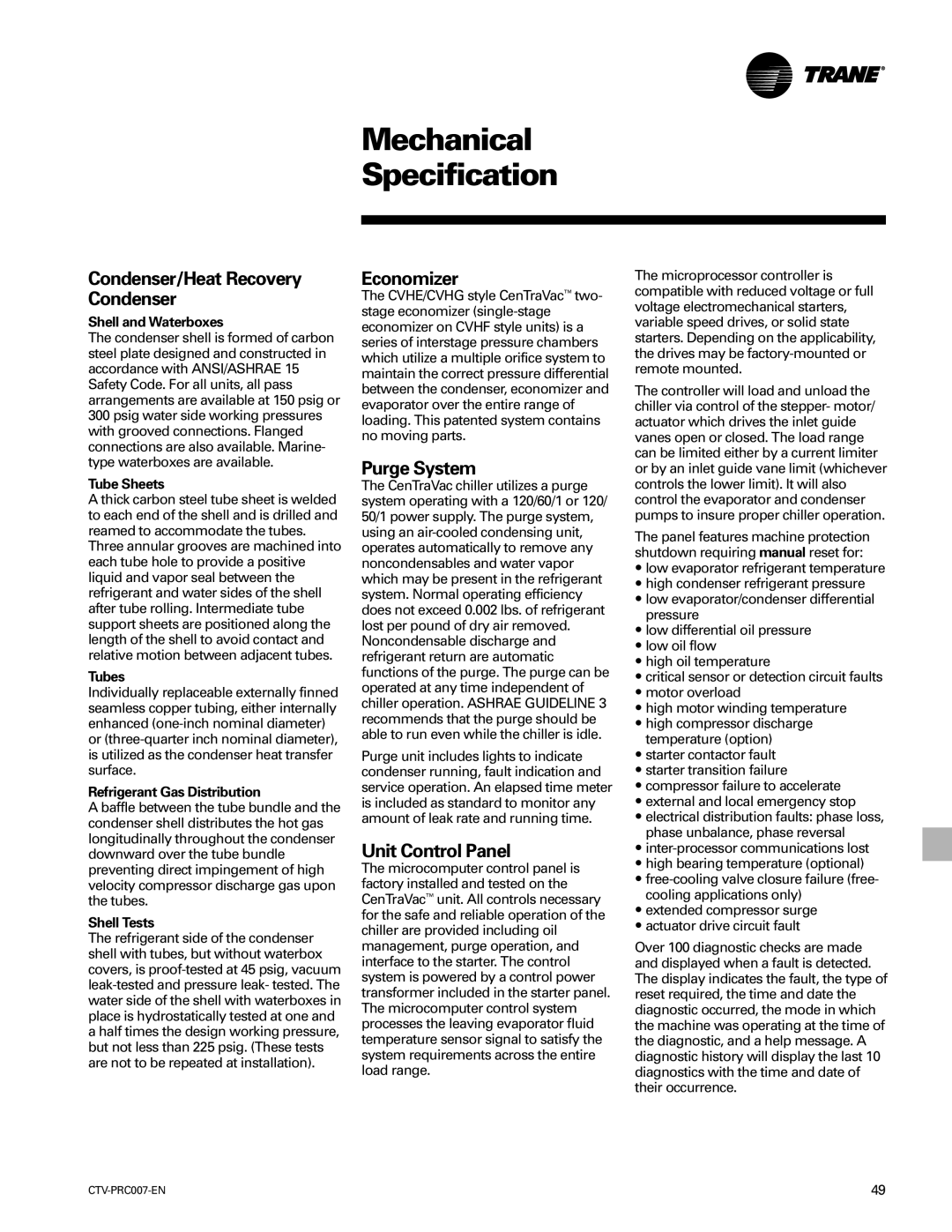Condenser/Heat Recovery Condenser
Shell and Waterboxes
The condenser shell is formed of carbon steel plate designed and constructed in accordance with ANSI/ASHRAE 15 Safety Code. For all units, all pass arrangements are available at 150 psig or 300 psig water side working pressures with grooved connections. Flanged connections are also available. Marine- type waterboxes are available.
Tube Sheets
A thick carbon steel tube sheet is welded to each end of the shell and is drilled and reamed to accommodate the tubes.
Three annular grooves are machined into each tube hole to provide a positive liquid and vapor seal between the refrigerant and water sides of the shell after tube rolling. Intermediate tube support sheets are positioned along the length of the shell to avoid contact and relative motion between adjacent tubes.
Tubes
Individually replaceable externally finned seamless copper tubing, either internally enhanced (one-inch nominal diameter) or (three-quarter inch nominal diameter), is utilized as the condenser heat transfer surface.
Refrigerant Gas Distribution
A baffle between the tube bundle and the condenser shell distributes the hot gas longitudinally throughout the condenser downward over the tube bundle preventing direct impingement of high velocity compressor discharge gas upon the tubes.
Shell Tests
The refrigerant side of the condenser shell with tubes, but without waterbox covers, is proof-tested at 45 psig, vacuum leak-tested and pressure leak- tested. The water side of the shell with waterboxes in place is hydrostatically tested at one and a half times the design working pressure, but not less than 225 psig. (These tests are not to be repeated at installation).
Economizer
The CVHE/CVHG style CenTraVac™ two- stage economizer (single-stage economizer on CVHF style units) is a series of interstage pressure chambers which utilize a multiple orifice system to maintain the correct pressure differential between the condenser, economizer and evaporator over the entire range of loading. This patented system contains no moving parts.
Purge System
The CenTraVac chiller utilizes a purge system operating with a 120/60/1 or 120/ 50/1 power supply. The purge system, using an air-cooled condensing unit, operates automatically to remove any noncondensables and water vapor which may be present in the refrigerant system. Normal operating efficiency does not exceed 0.002 lbs. of refrigerant lost per pound of dry air removed. Noncondensable discharge and refrigerant return are automatic functions of the purge. The purge can be operated at any time independent of chiller operation. ASHRAE GUIDELINE 3 recommends that the purge should be able to run even while the chiller is idle.
Purge unit includes lights to indicate condenser running, fault indication and service operation. An elapsed time meter is included as standard to monitor any amount of leak rate and running time.
Unit Control Panel
The microcomputer control panel is factory installed and tested on the CenTraVac™ unit. All controls necessary for the safe and reliable operation of the chiller are provided including oil management, purge operation, and interface to the starter. The control system is powered by a control power transformer included in the starter panel. The microcomputer control system processes the leaving evaporator fluid temperature sensor signal to satisfy the system requirements across the entire load range.
The microprocessor controller is compatible with reduced voltage or full voltage electromechanical starters, variable speed drives, or solid state starters. Depending on the applicability, the drives may be factory-mounted or remote mounted.
The controller will load and unload the chiller via control of the stepper- motor/ actuator which drives the inlet guide vanes open or closed. The load range can be limited either by a current limiter or by an inlet guide vane limit (whichever controls the lower limit). It will also control the evaporator and condenser pumps to insure proper chiller operation.
The panel features machine protection shutdown requiring manual reset for:
•low evaporator refrigerant temperature
•high condenser refrigerant pressure
•low evaporator/condenser differential pressure
•low differential oil pressure
•low oil flow
•high oil temperature
•critical sensor or detection circuit faults
•motor overload
•high motor winding temperature
•high compressor discharge temperature (option)
•starter contactor fault
•starter transition failure
•compressor failure to accelerate
•external and local emergency stop
•electrical distribution faults: phase loss, phase unbalance, phase reversal
•inter-processor communications lost
•high bearing temperature (optional)
•free-cooling valve closure failure (free- cooling applications only)
•extended compressor surge
•actuator drive circuit fault
Over 100 diagnostic checks are made and displayed when a fault is detected. The display indicates the fault, the type of reset required, the time and date the diagnostic occurred, the mode in which the machine was operating at the time of the diagnostic, and a help message. A diagnostic history will display the last 10 diagnostics with the time and date of their occurrence.

